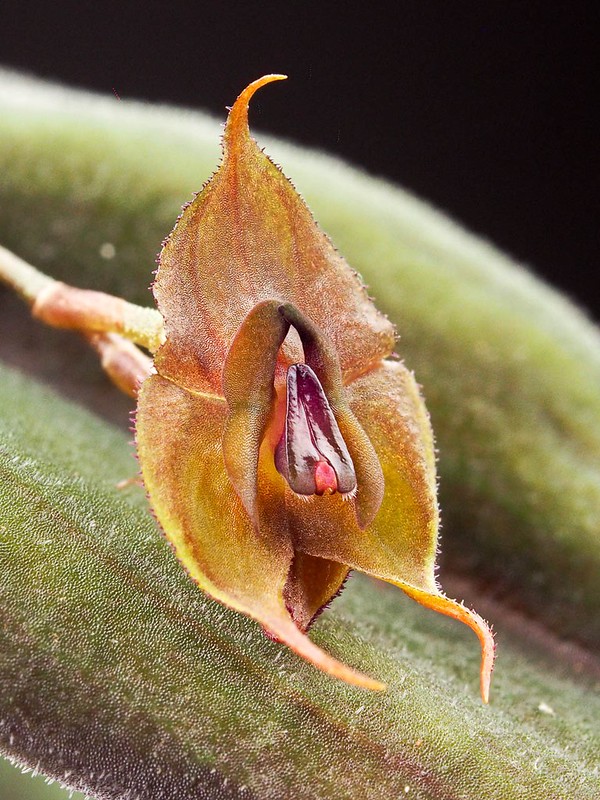
I got this plant as Lepanthes sp. aff. manabina from Equaflor-a in spring 2017. It was in a good condition from the beginning, and it started to recover/grow immediately. I wasn't paying too much attention to this plant, so I'm not sure when it started to flower, but I noticed lots of flowers in early October 2017. After going through all of >1000 photos of Lepanthes in Internet Orchid Species Photo Encyclopedia (IOSPE), I picked out a couple similar looking species with drab-colored, greenish, brownish flowers, and studied the illustrations of these candidate species. I'm pretty sure this plant is L. cincinnata. The species epithet is derived from Latin "cincinnatus", which means "with curly tufts", referring to the curly tips of the 3 sepals. At the end of this post, I'll try to explain the differences between these 5 species I picked as candidates.
According to IOSPE, L. cincinnata is from Valle del Cauca, Colombia in cloud forests at elevations around 2200 meters. Gilberto Merino, the owner of Equaflor-a, mentioned that he doesn't know the exact origin of this plant, but it is from Colombia. So it matches with the description.
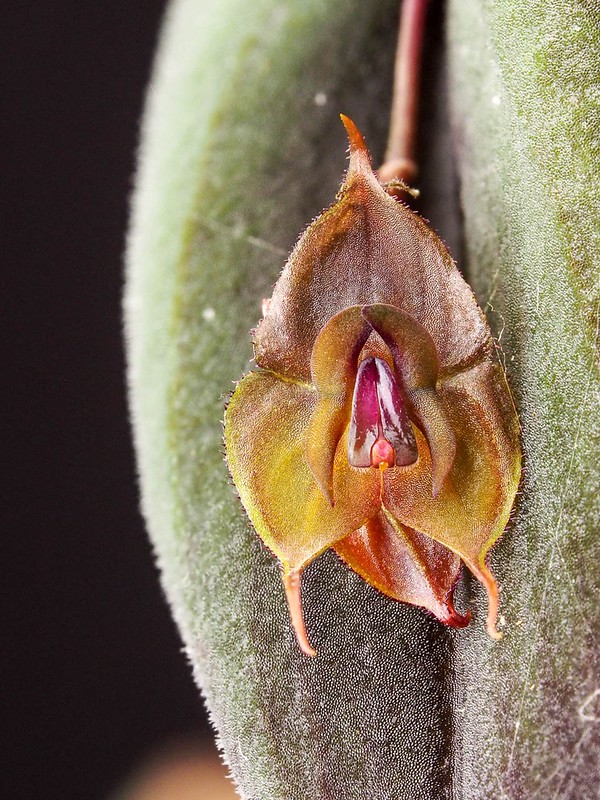
Flowers of Lepanthes have complicated structures, and I didn't know which parts corresponds to lip etc. The outermost, largest components of the flower in the photo above are the sepals. When you look at the middle part, you can see something like this. The brighter red part, closer to the bottom, is the column. The deeper wine-red parts, which is sandwiching the column from left and right are the lip. Then the two wings outside of the lip are the petals.
Note that there are hairs at the bottom of the lip, which we will talk about later.
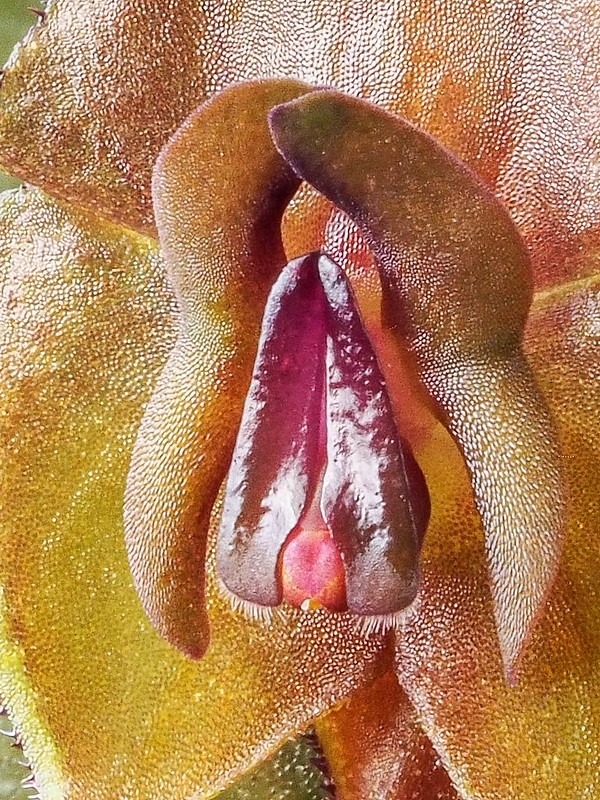
Below, you can see the ovary. Under the flower, you can see the next bud.
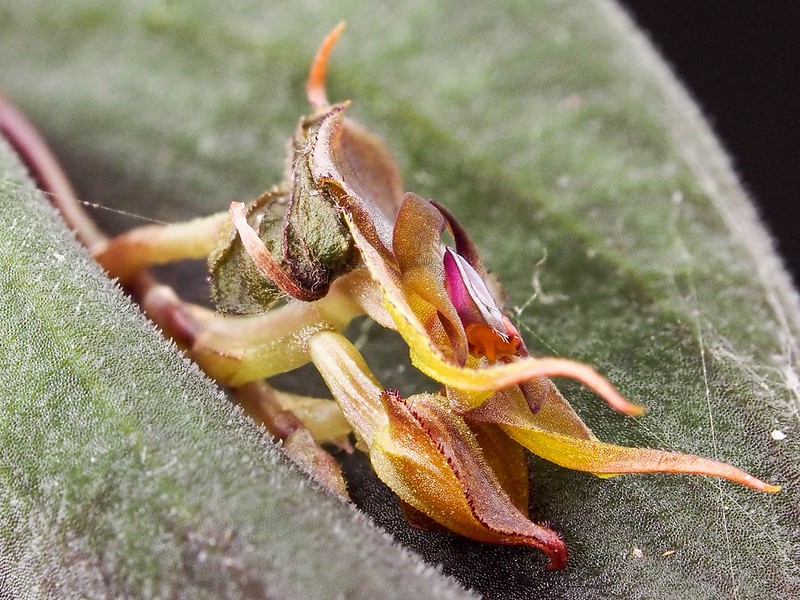
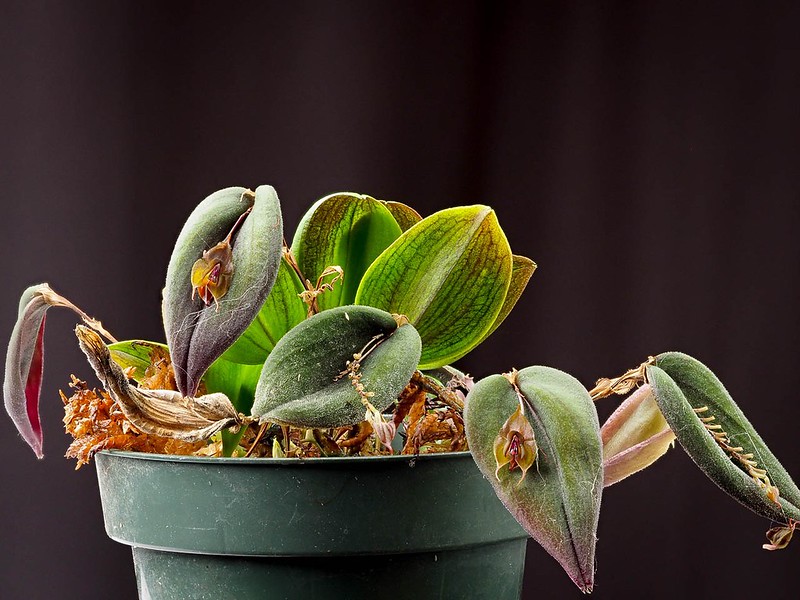
It is interesting that the texture of the leaves are different in fresh leaves. The 5 velvet-textured leaves at the edge of the pot are the old/original leaves. In the middle of the pot, there are about 5-6 smaller leaves, which were produced over this summer. The newer leaves are not so velvet-like, and much lighter in color. They almost look like different species. Some new leaves show the reticulation, too. It could be due to the young age of the leaves, but it is probably due to the environmental differences.
As a scale, the green pot is a 3" pot. So you can see the flowers are fairly large for Lepanthes.
I was playing with Sharpner Pro of free Google Nik Collection, which I'm not too familiar with. I did sharpen too much for these photos.
Comparison of similar species:
IOSPE has some good pointers to differentiate L. manabina, L. smaragdina, and L. ortiziana. In addition to these differences, I added a couple of my observations from studying the Luer's illustrations and photos available online. Since I haven't read all of the original descriptions, I may be wrong about how to differentiate them, so I appreciate it if you correct me if my interpretation is wrong.
 |
| © Missouri Botanical Garden. 2010. Lepanthes smaragdina Luer & R.Escobar, Swiss Orchid Foundation at the Herbarium Jany Renz. Botanical Institute, University of Basel, Switzerland. From Luer (2010). |
 |
| © Missouri Botanical Garden. 2010. Lepanthes ortiziana O.Pérez, E.Parra & Kolan., Swiss Orchid Foundation at the Herbarium Jany Renz. Botanical Institute, University of Basel, Switzerland. From Luer (2010). |
 |
| © Missouri Botanical Garden. 2010. Lepanthes cincinnata Luer & R.Escobar, Swiss Orchid Foundation at the Herbarium Jany Renz. Botanical Institute, University of Basel, Switzerland. From Luer (2010). |
 |
| © Missouri Botanical Garden. 1996. Lepanthes manabina Dodson, Swiss Orchid Foundation at the Herbarium Jany Renz. Botanical Institute, University of Basel, Switzerland. From Luer (1996), same figure also in Luer (2010). |
First, you can look at the tips of the sepals (red and orange circles). L. manabina and L. cincinnata have long pointy tails, but L. smaragdina does not have the tails. L. ortiziana has short tails, but not as long as L. manabina and L. cincinnata.
Between the short tailed speices, there are two obvious differences between L. smaragdina and L. ortiziana. The tips (points) of the right and left lateral sepals (orange circle) are close to each other in L. smaragdina, but the tips are spreading in L. ortiziana. Additionally, the top part of the petals are fatter and more hook shaped in L. ortiziana than in L. smaragdina.
Between the long tailed species, L. cincinata and L. manabina differ in the lip shapes (blue arrows). The bottom of the lip (blue arrow) is pretty blunt and almost flush to the bottom of the column (red arrow) in L. cincinnata. In a high magnification, you can see the hair at the bottom of the lip. In L. manabina, the bottom of the lip (blue arrow) sticks down below the column (red arrow), and there is no hair. In the figure of the lip, the bottom of the lip looks blunt, but in most other photos, the bottom of the lip looks more pointy, more like the top right illustration of the intact (i.e. not dissected) flower. Also, the petals (yellow circle) have short hairs in L. manabina. On the other hand the petals of L. cincinata has some textures, but I did not see any hairs.
In the past, L. gargoyla was incorrectly sold as L. manabina. The tails of the sepals are long in both species. However, the sepals of L. gargoyla is contoured while the sepals of L. manabina are relatively flat. The shape of the lip is quite different. The lip of L. gargoyla is more similar to L. cincinata and the bottom of the lip is level with the bottom of column, and you can see hairs. Finally, the top part of the petals are much fatter than L. manabina.
 |
| © Missouri Botanical Garden. 1996. Lepanthes gargoyla Luer & Hirtz, Swiss Orchid Foundation at the Herbarium Jany Renz. Botanical Institute, University of Basel, Switzerland. From Luer (1996) |
Below I'm including the photos of a couple species, so you can compare them with the illustrations. I couldn't find open-licensed photos of L. ortiziana.
 |
| © R. Kuehn. 2013. Lepanthes smaragdina Luer & R.Escobar, Swiss Orchid Foundation at the Herbarium Jany Renz. Botanical Institute, University of Basel, Switzerland. This plant obtained from Ecuagenera. |
Note that the tails of the sepals are short in L. smaragdina. Also, the bottom part of the lip is sticking down below the column.
 |
| © R. Jenny. Lepanthes manabina Dodson, Swiss Orchid Foundation at the Herbarium Jany Renz. Botanical Institute, University of Basel, Switzerland. |
 |
| © R. Jenny. Lepanthes gargoyla Luer & Hirtz, Swiss Orchid Foundation at the Herbarium Jany Renz. Botanical Institute, University of Basel, Switzerland. |
Literature Cited:
- Luer, C. A. 1996. Icones Pleurothallidinarum XIV. Missouri Botanical Garden Press, St. Louis, MO, USA
- Luer, C. A. 2010. Icones Pleurothallidinarum XXXII - Lepanthes of Colombia. Missouri Botanical Garden Press, St. Louis, MO, USA
Comments
Post a Comment